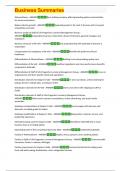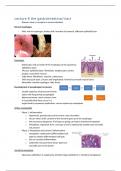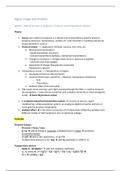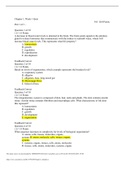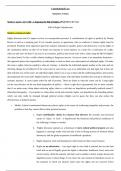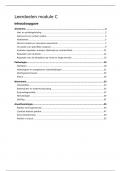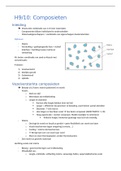What are the 3 determinants of price Where does the cost of production
elasticity of demand? depend upon?
What is the difference between What shape does the average cost
economic costs and accounting costs? curve usually have?
What is the difference between fixed Name 5 assumptions of the perfect
costs in the short run and fixed costs market model.
in the long run?
How does a firm maximize profit? (At In which three cases would a firm
which point do they produce?) decide to shut down?
(shut down exit the market)
In the long run, until what point will What is the key efficiency condition?
firms exit/enter the market?
Name 4 things that reveal the What is the
existence of market failure. equilibrium in
the Edgeworth
box?
What are five possible barriers to What is the profit maximizing level of
entry? output for a pure monopoly?
What is de main difference in the long Collusion
run between perfect competition and
a monopoly?
, 1. the availability of substitutes
1. how much is produced
2. share of the item in the total budget (an
2. how much of each input factor is used illusion!)
3. time dimension (long term demand
3. unit cost (price) of input factors is more elastic)
The average cost curve is generally U- Accounting costs are the explicit costs,
shaped. economic costs are the implicit and the
explicit costs (which together form the
total opportunity costs).
1] There is perfect competition.
2] There is perfect knowledge.
In the short run, some costs are fixed, in
3] Property rights are fully defined. the long run, most fixed costs become
4] There is complete mobility of goods and variable costs.
production factors.
5] All consumers and producers act rational.
1. when TR < VC A firm maximizes profit by producing
2. when TR/Q < VC/Q the quantity at which marginal costs
3. when P < AVC (MC) equals marginal revenue (MR).
(only VARIABLE costs are considered)
P = MC Firms will exit/enter the market until
profit is driven to zero (the firms
The price equals the marginal costs. revenue equals the opportunity costs).
The point at which negotiations are 1. Imperfect Markets
possible, is the point where the two lines 2. Public Goods
of the two people cross. There, 3. Externalities
negotiation is possible. 4. Imperfect Information
1. Government franchises
MR = MC 2. Patents
3. Reputation/Brand Name
4. Ownership of Scarce Factor of Production
5. Increasing Returns to Scale (Natural
Monopoly)
The act of working together with other In perfect competition the price will be
producers in an effort to limit equal to the average costs, resulting in
competition and increase joint profit. zero profit. A monopoly sets the price
[e.g. cartel practices] and the quantity, thus is able to make a
profit.
elasticity of demand? depend upon?
What is the difference between What shape does the average cost
economic costs and accounting costs? curve usually have?
What is the difference between fixed Name 5 assumptions of the perfect
costs in the short run and fixed costs market model.
in the long run?
How does a firm maximize profit? (At In which three cases would a firm
which point do they produce?) decide to shut down?
(shut down exit the market)
In the long run, until what point will What is the key efficiency condition?
firms exit/enter the market?
Name 4 things that reveal the What is the
existence of market failure. equilibrium in
the Edgeworth
box?
What are five possible barriers to What is the profit maximizing level of
entry? output for a pure monopoly?
What is de main difference in the long Collusion
run between perfect competition and
a monopoly?
, 1. the availability of substitutes
1. how much is produced
2. share of the item in the total budget (an
2. how much of each input factor is used illusion!)
3. time dimension (long term demand
3. unit cost (price) of input factors is more elastic)
The average cost curve is generally U- Accounting costs are the explicit costs,
shaped. economic costs are the implicit and the
explicit costs (which together form the
total opportunity costs).
1] There is perfect competition.
2] There is perfect knowledge.
In the short run, some costs are fixed, in
3] Property rights are fully defined. the long run, most fixed costs become
4] There is complete mobility of goods and variable costs.
production factors.
5] All consumers and producers act rational.
1. when TR < VC A firm maximizes profit by producing
2. when TR/Q < VC/Q the quantity at which marginal costs
3. when P < AVC (MC) equals marginal revenue (MR).
(only VARIABLE costs are considered)
P = MC Firms will exit/enter the market until
profit is driven to zero (the firms
The price equals the marginal costs. revenue equals the opportunity costs).
The point at which negotiations are 1. Imperfect Markets
possible, is the point where the two lines 2. Public Goods
of the two people cross. There, 3. Externalities
negotiation is possible. 4. Imperfect Information
1. Government franchises
MR = MC 2. Patents
3. Reputation/Brand Name
4. Ownership of Scarce Factor of Production
5. Increasing Returns to Scale (Natural
Monopoly)
The act of working together with other In perfect competition the price will be
producers in an effort to limit equal to the average costs, resulting in
competition and increase joint profit. zero profit. A monopoly sets the price
[e.g. cartel practices] and the quantity, thus is able to make a
profit.

